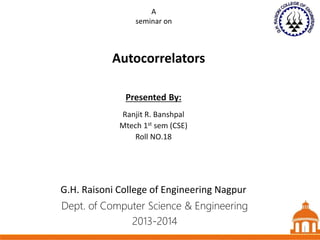Autocorrelators1
- 1. 1 Autocorrelators Dept. of Computer Science & Engineering 2013-2014 Presented By: Ranjit R. Banshpal Mtech 1st sem (CSE) Roll NO.18 1 A seminar on G.H. Raisoni College of Engineering Nagpur 1
- 2. Autocorrelators ïķ Autocorrelators easily recognized by the title of Hopfield Associative Memory (HAM). ïķ First order autocorrelators obtain their connection matrix by multiplying a patternâs element with every other patternâs elements. ïķ A first order autocorrelator stores M bipolar pattern A1,A2,âĶâĶâĶ,Am by summing together m outer product as
- 3. Here, is a (p à p) connection matrix and p ïķ The autocorrelatorâs recall equation is vector-matrix multiplication, ïķ The recall equation is given by, =f ( ) Where Ai=(a1,a2,âĶ..,ap) and two parameter bipolar threshold function is, 1, if Îą > 0 f(Îą , Îē )= Îē, if Îą = 0 -1, if Îą < 0
- 4. Working of an autocorrelator Consider the following pattern, A1=(-1,1,-1,1) A2=(1,1,1,-1) A3=(-1,-1,-1,1) The connection matrix, 3 1 3 -3 4Ã1 1Ã4 1 3 1 -1 3 1 3 -3 -3 -1 -3 3
- 5. Recognition of stored patterns ïķ The autocorrelator is presented stored pattern A2=(1,1,1,-1) With the help of recall equation = f ( 3 + 1 + 3 + 3, 1 ) = 1 = f ( 6, 1 ) = 1 = f ( 10, 1 ) = 1 = f ( -10, 1 ) = -1
- 6. Recognition of noisy patterns ïķ Consider a vector Aâ=(1,1,1,1) which is a distorted presentation of one among the store pattern ïķ With the help of Hamming Distance measure we can find noisy vector pattern ïķ The Hamming distance (HD) of vector X from Y, given X=(x1,x2,âĶ.,xn) and Y=(y1,y2,âĶ.,yn) is given by, HD( x, y ) =
- 7. Heterocorrelators : Koskoâs discrete BAM ïķ Bidirectional associative memory (BAM) is two level nonlinear neural network ïķ Kosko extended the unidirectional to bidirectional processes. ïķ Noise does not affect performance ïķ There are N training pairs {(A1,B1),(A2,B2),âĶ.,(Ai,Bi),âĶâĶ,(An, Bn)} where Ai=(ai1,ai2,âĶâĶ.,ain) Bi =(bi1,bi2,âĶâĶ,bip)
- 8. ïķHere, aij or bij is either ON or OFF state ïķIn binary mode, ON = 1 and OFF = 0 and In bipolar mode, ON = 1 and OFF = -1 ïķ Formula for correlation matrix is, ïķ Recall equations, Starting with (Îą, Îē) as the initial condition, we determine the finite sequence (Îąâ, Îēâ ),(Îąââ, Îēââ),âĶâĶ.., until equilibrium point (ÎąF, Îē F ) is reached. Here , Îēâ = Ï (ÎąM) Îąâ = Ï (Îēâ MT)
- 9. ÎĶ(F) = G = g1, g2, âĶ., gn F = ( f1,f2,âĶ.,f n) 1 if fi > 0 0 (binary) gi = , fi < 0 -1 (bipolar) previous gi, fi = 0
- 10. Addition and Deletion of Pattern Pairs ïķIf given set of pattern pairs (Xi, Yi) for i=1,2,âĶ.,n ïķ Then we can be added (Xâ,Yâ) or can be deleted (Xj,Yj) from the memory model. ïķ In the case of addition, ïķ In the case of deletion,
- 11. Energy function for BAM ïķ The value of the energy function for particular pattern has to occupy a minimum point in energy landscape, ïķ Adding new patterns do not destroy previously stored patterns.
- 12. ïķ Hopfield propose an energy function as, E(A) = -AMAT ïķ Kosko propose an energy function as, E(A,B)= - AMBT ïķ If energy function for any point (Îą, Îē) is given by E = - ÎąMÎēT ïķ If energy E evaluate using the coordinates of the pair (Ai,Bi),
- 13. ïķ Working of Koskoâs BAM ïķStep 1: converting to bipolar forms ïķ Step 2: The matrix M is calculated as, ïķ Step 3: Retrieve the associative pair Îēâ = Ï (ÎąM) Îąâ = Ï (Îēâ MT)
- 14. THANK YOUâĶ!!!














